
As I promised in my initial presentation to the whole #HIVE community, today I am publishing my first article in this Community that, I believe, will be my favorite in the future, since most of what I do, as a hobby and not professionally, is related to vegetable gardening and gardening in general.
A way of spending time after having reached the pensionable age that allows me not only not to exercise my profession (accountant) but mainly to devote myself to some hobbies that, because of the dedication to work and family, were forgotten for decades.
At this time of the year in this part of the southern hemisphere we are reaching the end of winter (according to the calendar it only ends on September 20, although in reality the seasons of the year do not exactly follow the calendar dates).
Already from mid-August onwards the change in the weather begins to make itself felt and the plants start to react with the magical laws of nature. Little by little the new buds begin to appear, the buds begin to "explode" and the arrival of the bees foreshadows what will later be a festival of flowers.
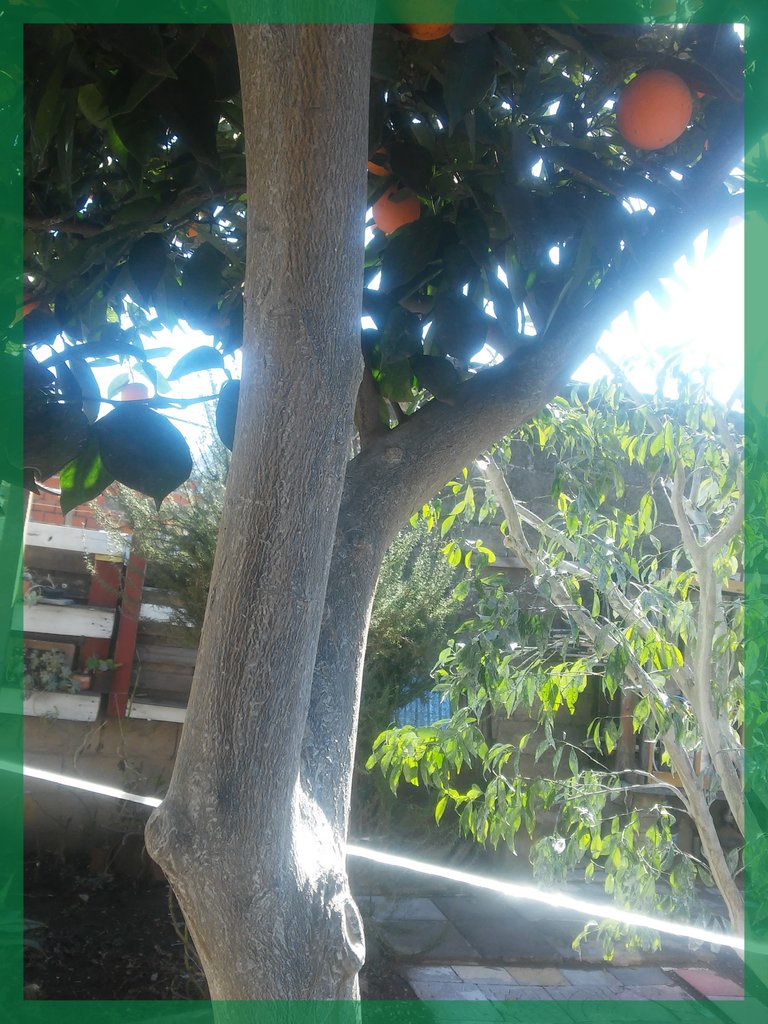
That is why winter, with its inclement days and constant cold, is a good period to do work that we cannot do at other times of the year.
In my case and as I mentioned in the initial post, the "white cochineal, cotonet or cottony cochineal" as it is commonly called (the scientific name is Planoccocus citri) attacks relentlessly throughout the year to fruit plants, especially citrus trees poorly ventilated, ie little subject to drafts.
My plants (two orange trees and a mandarin) had been quite affected and although it is a fruit quite resistant to the invasion of these pests (it is not easy to pierce its peel) in many cases I discovered that they had.
For that reason taking advantage of the two or three hours after noon when the temperature begins to rise during these months I have dedicated myself with enthusiasm to their elimination.
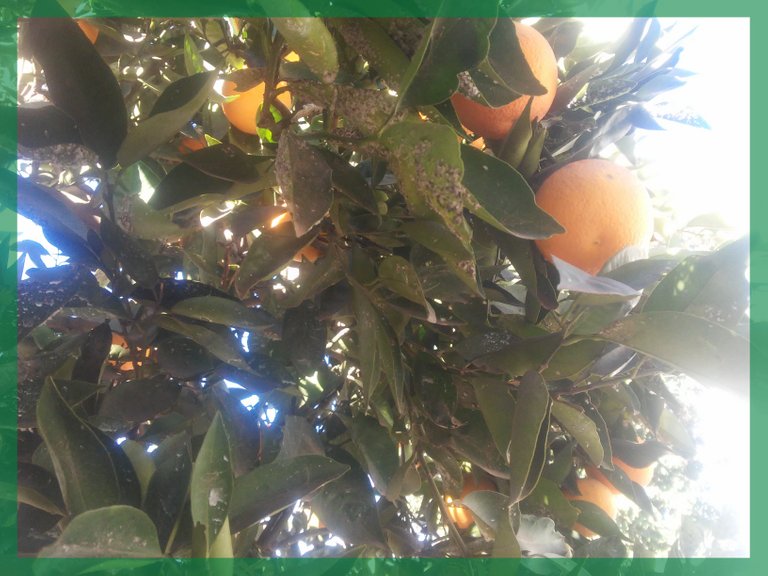
And for this I have had to resort, for the first time, to a drastic pruning, leaving only the branches and the healthiest leaves, after cleaning one by one with a brush and a solution composed of potassium soap, neem oil and water.
In another I will explain the exact composition of each of these elements to effectively combat this pest and not damage the plant.
It is important to do this work when the fruit tree is resting (the sap is in the lower part of the plant) and does not suffer the effects of pruning, no matter how drastic it may be. Pruning in the spring means reducing its lifespan and also the quality of fruit production.
During the autumn-winter of last year I had taken on a truly singular job: to clean all the leaves (or most of them) one by one, eliminating very few branches. It was no use. The sup0rstites mealybugs continued to reproduce and do damage.

So this winter I decided to act more energetically and do a complete pruning.
The biggest problem I had is the limited time since citrus trees have a very short period between the production of fruit and the emergence of new leaves and flowers.
To be clear: an orange or tangerine plant bears fruit from the month of May when they start to ripen (late fall and early winter) until the month of August or even September which is exactly when the new flowers emerge with the approach of spring.
Therefore the time available to do all the work is barely one month (last days of winter). Otherwise, as I did with my fruit trees, I picked the "harvest" of fruit a month earlier and let it finish ripening in crates and boxes that I left outside in the yard to get as much sunlight as possible.
Having made this introduction, I will now detail the work I have done.
Cleaning and sanitizing the tools to be used.
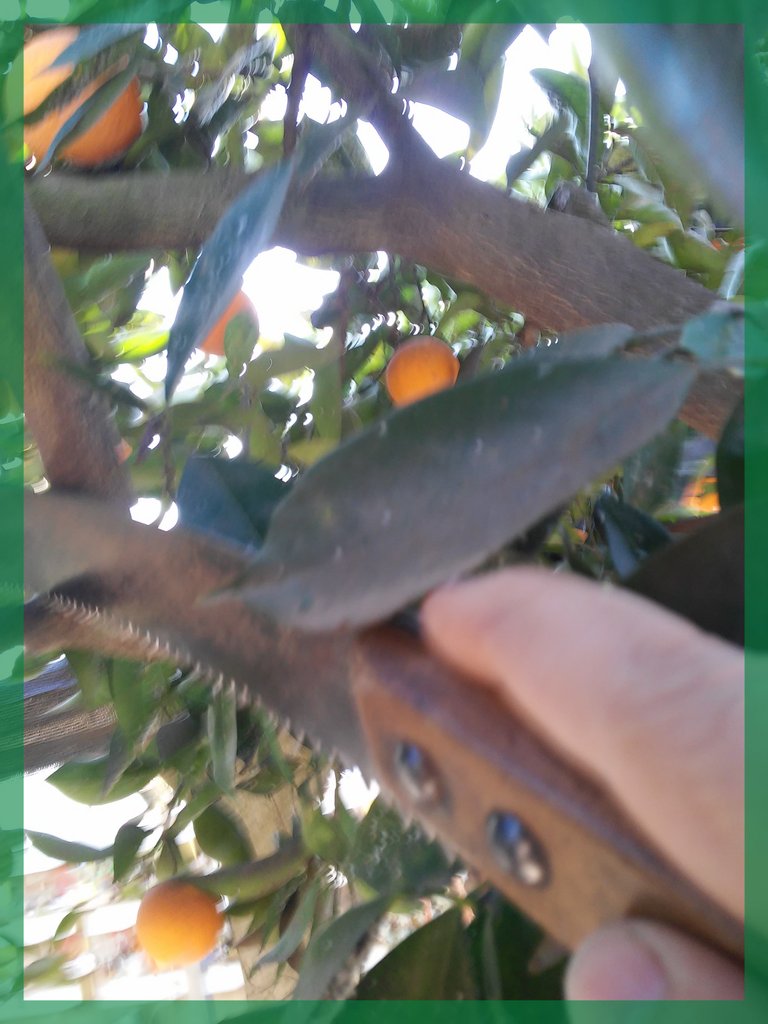
Although it may seem an exaggeration it is a good practice to sanitize (with the same solution used for spraying) the cutting blades of the used scissors and/or pruning shears.
A plant is a living organism, and as such can become infected like humans through bacteria and/or microbes that penetrate into its interior.
If we have been cutting a badly infected branch with the scissors and/or the saw and there are residues of the same pest on the leaf, when we make a new cut we can transmit the disease to the plant.
For this reason it is important to purify the cuts made and, from time to time, clean the leaves of the scissors or the saw.
There are plants that resist pests without problems but there are others that end up having too short a life span due to pests.
Eliminate only the branches that are very infected with care.
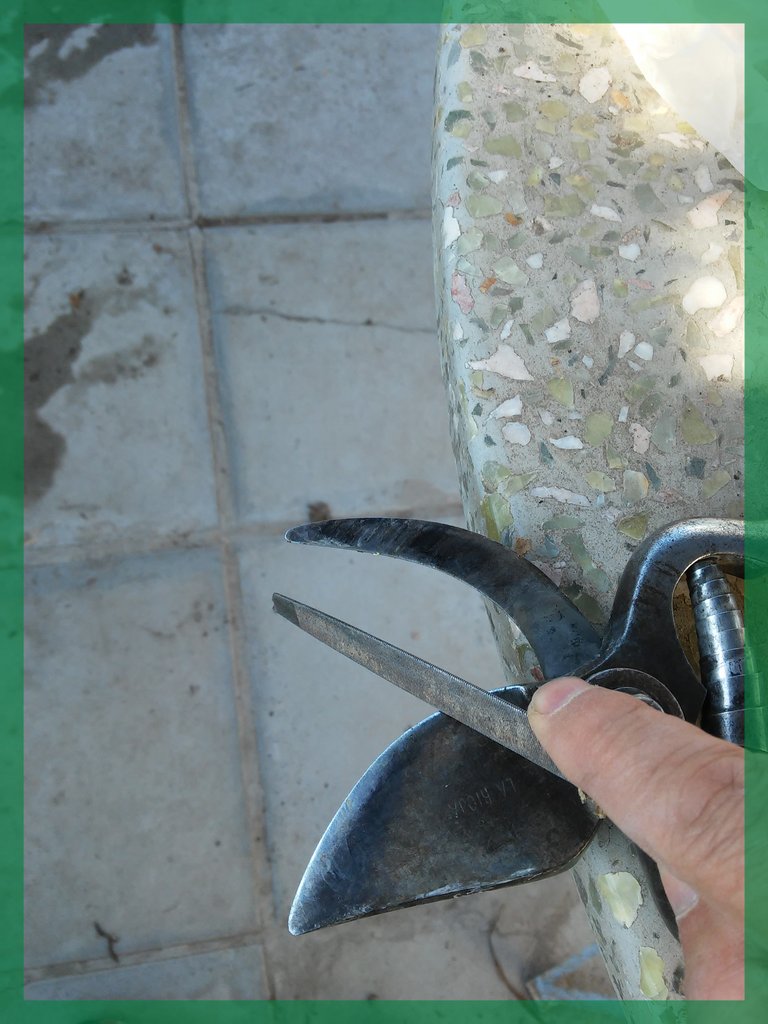 | 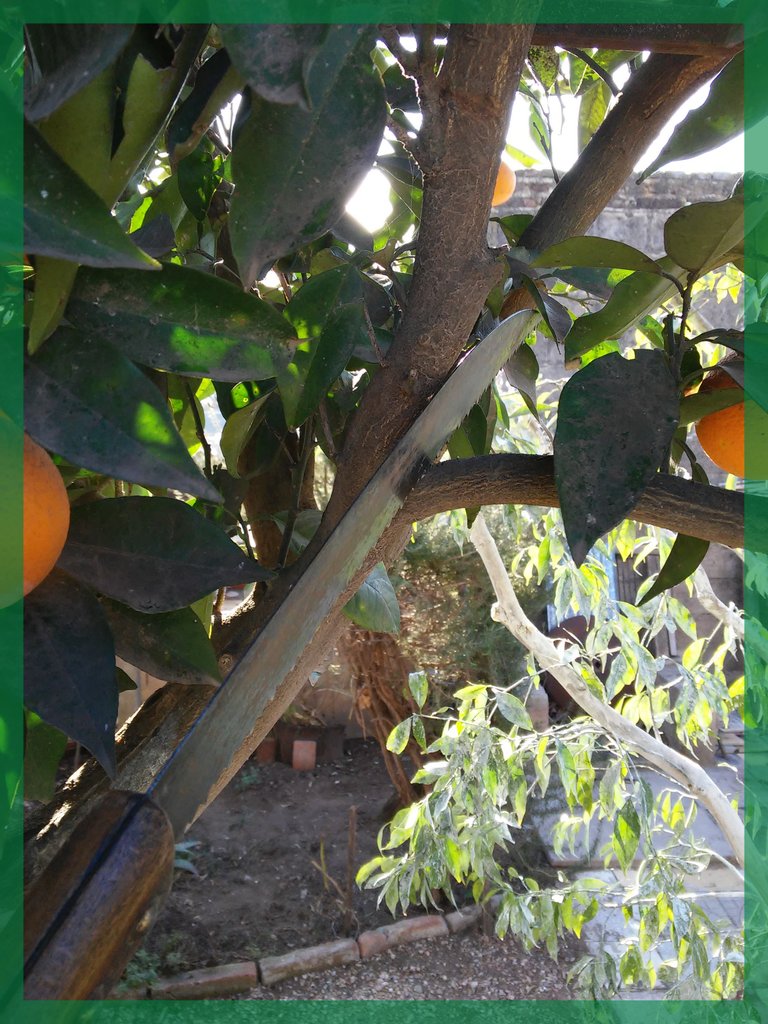 |
|---|
Although we can see hundreds of videos on YouTube and similar platforms explaining (with few details) how to eliminate pests from plants in an almost magical way, showing us images that are just montages or avoid describing in detail the full details of the operation, the truth is that it is very difficult to combat pests.
To fight them effectively, I mean. For example, we see a person in a video spraying an entire fruit plant. However the white mealybug to give an example nests on the lower part of the leaves. For this reason by applying it from above the pesticide does not reach where the pest is. And if it does, its effect is so weak that it does not reach the larvae.
For this reason, manual action is necessary. Yes, leaf by leaf, there is no alternative. For that reason the radical pruning I did this year- The remaining leaves I cleaned them one by one with a small brush dipped in the solution potassium soap + neem oil + lime life - hence the white color you see on the leaves- The c al vida diluted in water is one of the best sanitizers for environments and was used in colonial times in many homes in Latin America to simply paint the walls of the houses.
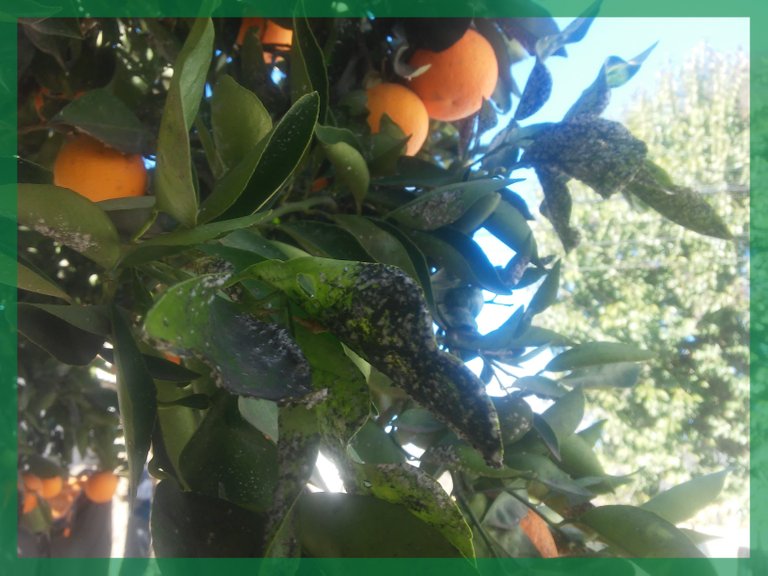
If the plant is badly infected as in my case a vigorous pruning will allow to control this pest in the future with periodic applications with a simple sprayer like the one I am using and you can see in the photos. On the trunk and the remaining leaves at least once a month until they begin to bloom.
Then we wait for the flower to close and the fruit to appear, albeit small, and start spraying again once a month.
Never spray on the flower because this will eliminate the possibility of the fruit being born.
As soon as the first leaves and flowers start to appear I will make another post to show you how the plant is evolving in general and the effects of the work done.
If the trunks are thick I use an electric saw for family use, one of those that are used to cut small wood, in short, for family use, not professional use.
Otherwise my favorite tools are the pruning saw and the classic scissors (mine is many years old, it is a gift from my father).
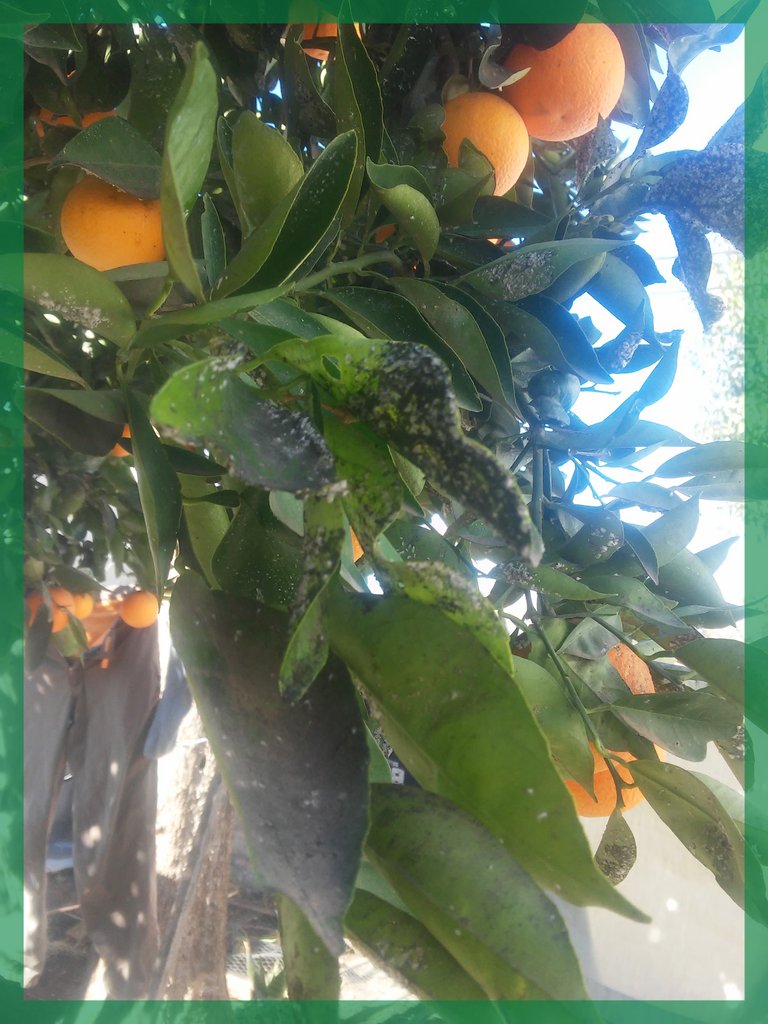
The purpose of using the saw is that the cut of the branch is always oblique and clear to prevent the prolonged lodging of water and the entry of any pest.
Once the cut is made, we paint it several times with the brush so that it heals quickly. In my case, I thicken the solution described above with a spoonful of quicklime so that it remains dense and consistent, only in this case, to apply to the cuts made.
Also in this case you can find in the market products based on vegetable resin to favor the healing of the cuts. I always try to use "domestic" products, homemade by myself. And I leave to buy in the trade what I can not really obtain by myself.
Another very important aspect is that the cutting tools (scissors and saws) are well sharpened so that the cuts are clean.
Spray trunk and branches after pruning.
 |  |
|---|
Probably it gives us a little pity to see the plant totally depopulated of branches and leaves, but we have done it for its good. We will see how splendid it will be in mid spring or early summer.
In the meantime it is time to dedicate ourselves to the "painting". This is a one-time task, since we will use the much faster spraying later on.
We carefully paint the entire trunk a couple of times so that the lime, potassium soap and neem oil are well absorbed in the trunk.
We check all the leaves well and carefully with a brush we remove all the residues of the white mealybug that we see. The procedure is very simple: we turn the leaf delicately in the palm of our hand and we paint it several times with the brush with relative energy until we have eliminated the pest.
Then we paint the branch and so on until the whole plant is finished. It is necessary to leave the plant some leaves (a hundred or so is fine) because it needs them to breathe.
Otherwise the plant suffocates and begins to crack the trunk looking for oxygen. These are the classic "sores" that can be seen in many fruit plants, in a circular shape.
Once the painting is finished we wait a week and now, sprayer in hand, we give it a good spray with the solution that we have prepared based on potassium soap and neem oil diluted in water. The quicklime is no longer necessary but would also clog the sprayer.
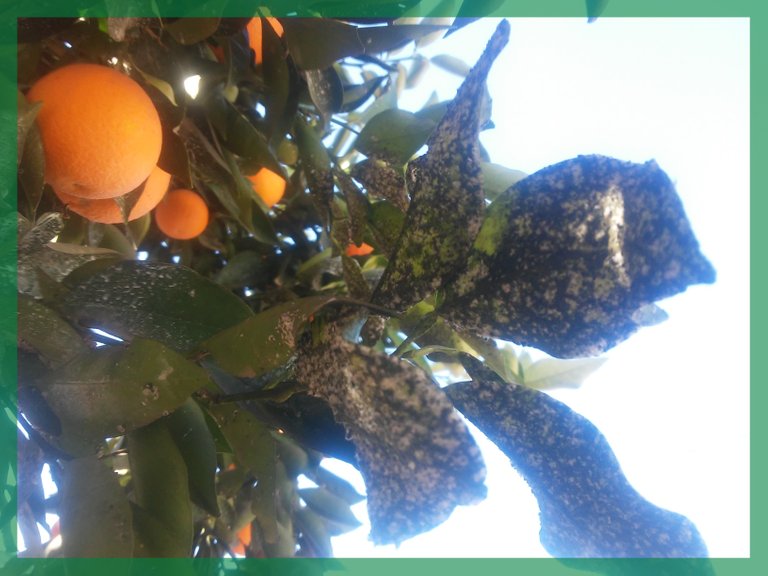
In some photos of this post you can see the finished work in two citrus plants (a mandarin and an orange tree) while in the other plant (another orange tree) all the work is still to be done. It is a slower variety that flowers and fruits later. And therefore it gives me more time for pruning and final care.
This post is written in the month of August (early days), a little more than a month before the beginning of spring.
As soon as the garden has been invaded by bees, new buds and flowers, I promise to publish the epilogue of this story.
In the meantime, read on!

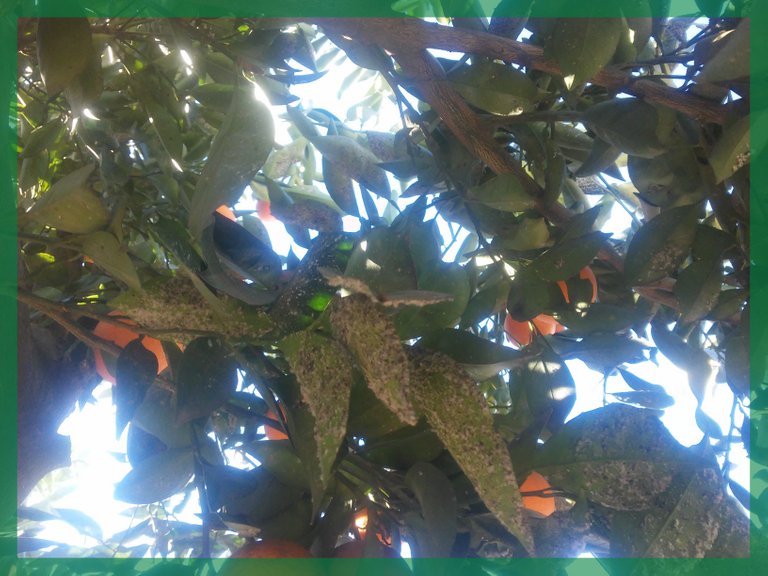
Tal como les prometí en mi presentación inicial a toda la comunidad de #HIVE hoy publico mi primer artículo en esta Comunidad que, creo, será en el futuro mi favorita, ya que la mayor parte de lo que hago, como hobby y no en forma profesional, está relacionado con la huerta y la jardinería en general.
Un modo de pasar el tiempo después de haber alcanzado la edad pensionable que me permite no solo no ejercer más mi profesión (la de contador) sino principalmente la de dedicarme a algunos hobbies que, a causa de la dedicación al trabajo y a la familia, quedaron olvidados por décadas.
En esta época del año en esta parte del hemisferio sur estamos llegando al final del invierno (por el calendario recién termina el 20 de septiembre aunque en realidad las estaciones del año no siguen exactamente las fechas del calendario previstas).
Ya a partir de mediados de agosto el cambio del clima comienza a hacerse sentir y las plantas comienzas a reaccionar con las leyes mágicas de la naturaleza. Comienzan a aparecer de a poco los nuevos brotes, las yemas comienzan a "explotar" y la llegada de las abejas preanuncia lo que más adelante será un festival de flores.
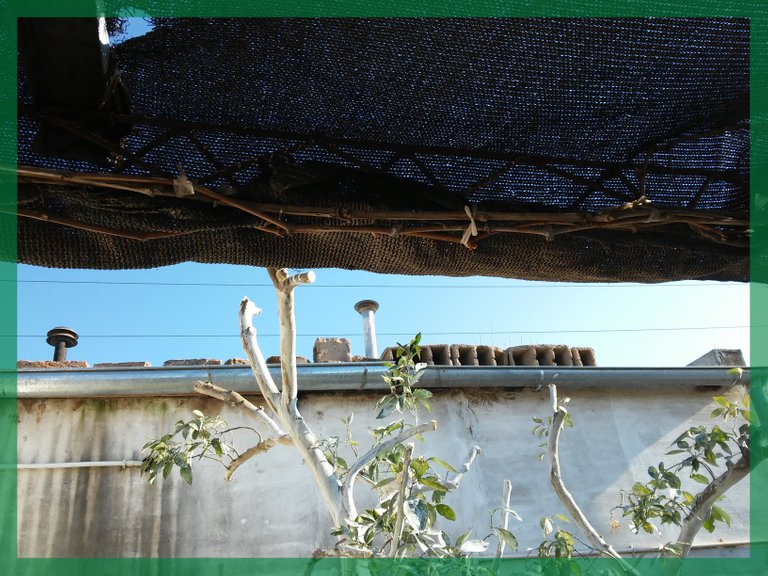
Por ese motivo el invierno, con sus días inclementes y el frío constante, es un buen período para hacer trabajos que en otra época del año no podemos hacerlo.
En mi caso y tal como les comenté en el post inicial, la "cochinilla blanca, cotonet o cochinilla algodonosa" como se la llama vulgarmente (el nombre científico es Planoccocus citri) ataca sin tregua durante todo el año a las plantas frutales, especialmente los cítricos poco ventilados, es decir poco sujetos a las corrientes de aire.
Mis plantas (dos naranjos y un mandarino) habían sido bastante afectados y a pesar de que es una fruta bastante resistente a la invasión de estas plagas (no es fácil perforar su cáscara) en muchos casos descubrí que si lo habian hecho.
Por ese motivo aprovechando las dos o tres horas después del mediodia cuando la temperatura comienza a salir durante estos meses me he dedicado con entusiasmo a su eliminación.
Y para ello he tenido que recurrir, por primera vez, a una poda drástica, dejando solo las ramas y las hojas mas sanas, previa limpieza una por uno con un pincel y una solucion compuesta por jabon potasico, aceite de neem y agua.
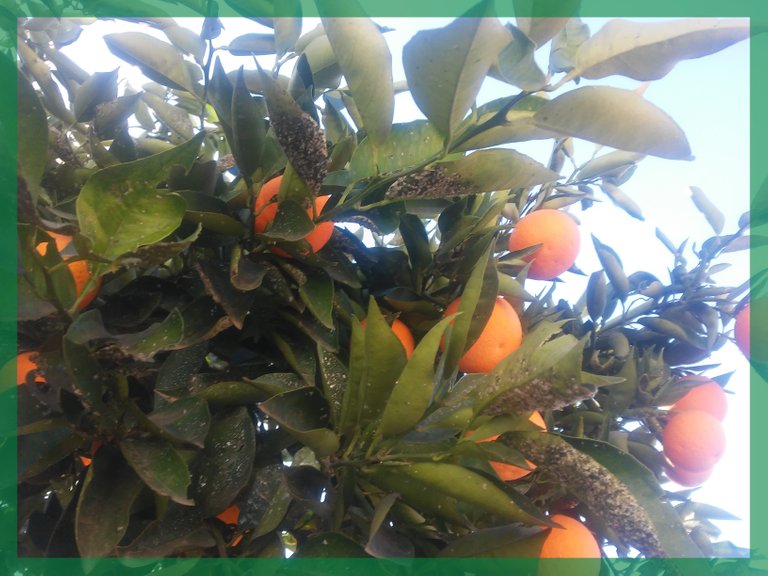
En otro les explicaré la composicion exacta de cada uno de estos elementos para combatir con eficacia esta plaga y no dañar la planta.
Este trabajo es importante hacerlo cuando el frutal esta en reposo (la savia esta en la parte baja de la planta) y no sufre en consecuencia los efectos de la poda, por mas drastica que esta sea. Podarla durante la primavera significa reducir su vida util y tambén la calidad en la produccion de fruta.
Durante el otoño invierno del año pasado me habia tomado un trabajo verdaderamente singular: limpiar todas las hojas (o la mayor parte) una por una eliminando muy pocas ramas. No hubo caso. Las cochinillas sup0rstites continuaron a reproducirse y a hacer daño.
De manera que este invierno decidí actuar con mayor energia y hacer una poda completa.
El mayor problema que tuve es el tiempo limitado ya que los cítricos tienen un per íodo muy corto entre la produccion de la fruta y el surgimiento de las nuevas hojas y flores.
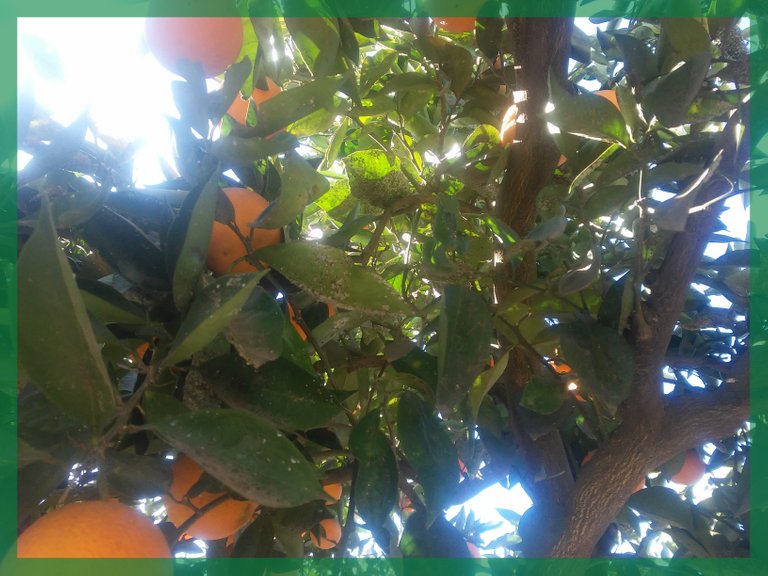
Para ser claro: una planta de naranja o mandarina da frutos desde el mes de mayo en que comienzan ya a madurar (fines de otoño y principios de invierno) hasta el mes de agosto o incluso septiembre que es exactamente cuando surgen las nuevas flores con el aproximarse de la primavera.
Por lo tanto el tiempo disponible para hacer todo el trabajo es de escasamente un mes (ultimos dias del invierno). O caso contrario, como hice con mis frutales, recogí la "cosecha" de fruta un mes antes y dejé que se terminara de madurar en cajones y cajas que dejé afuera en el patio para que recogieran la mayor luz solar.
Hecha esta introduccion paso a detallarles el trabajo hecho.
Limpiar y sanificar las herramientas a usar.
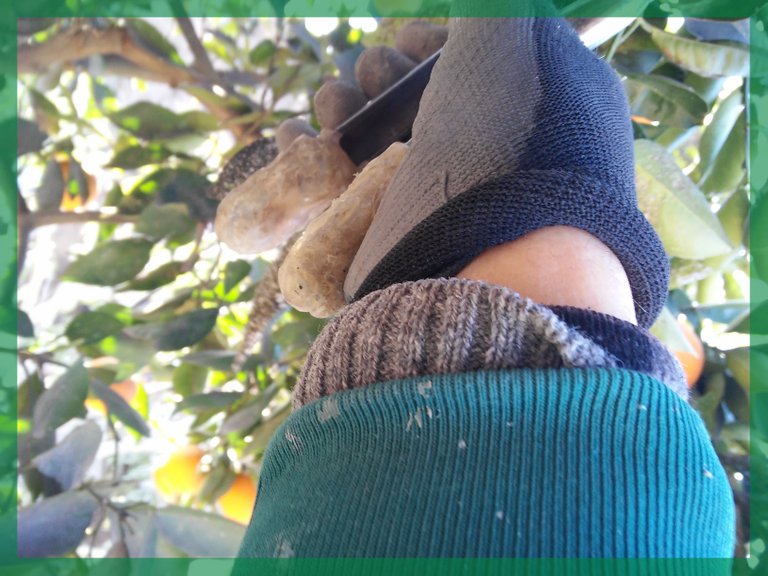
Aunque parezca una exageración es una buena buena práctica sanificar (con la misma solución usada para pulverizar) las hojas de corte de la tijera y/o del serruccho usados.
Una planta es un organismo viviente, y como tal puede infectarse como los seres humanos a través de bacterias y/o microbios que penetren en su interior.
Si hemos estado cortando una rama muy infectada con la tijera y/o el serrucho y quedan residuos de la misma plaga en la hoja, al efectuar un nuevo corte podemos transmitir a la planta la enfermedad.
Por ese motivo es importante purificar los cortes efectuados y, de vez, en cuando, limpiar las hojas de la tijera o el serrucho.
Hay plantas que resisten sin problemas a las plagas pero hay otras que terminan por tener una vida demasiado breve por efecto de las mismas.
Eliminar solo las ramas que están muy infectadas con cuidado.
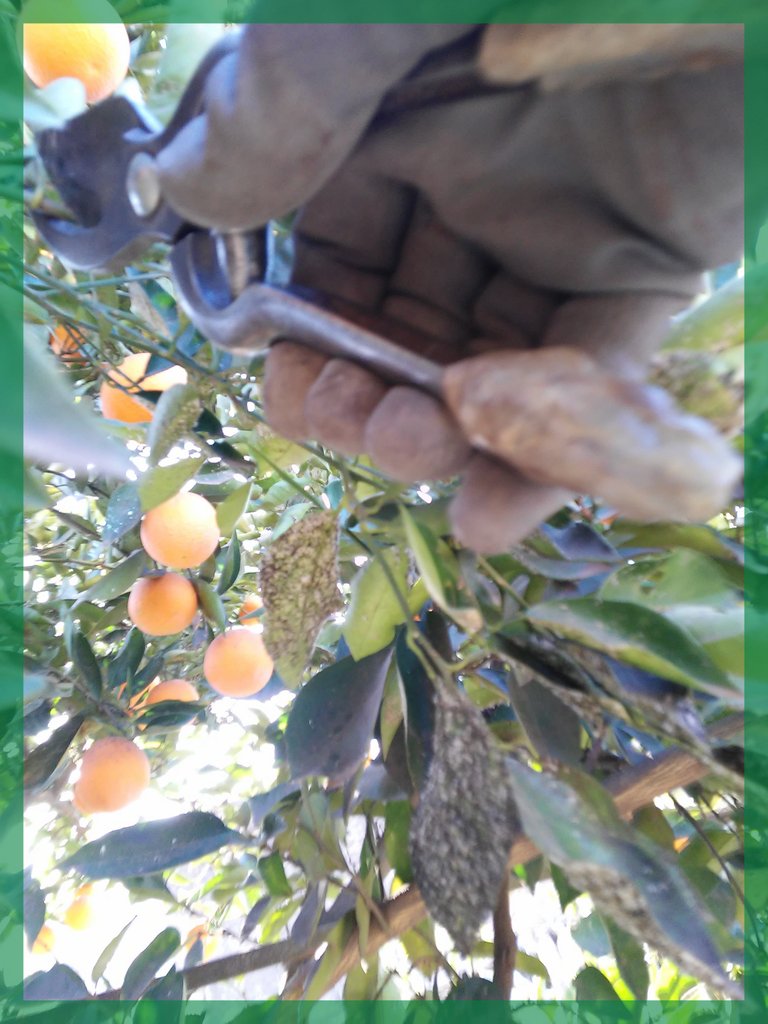
Si bien podemos ver centenares de videos en YouTube y plataformas similares explicando (con pocos detalles) como se hace para eliminar las plagas de las plantas en un modo casi mágico, mostrándonos imágenes que son solo montajes o evitan de describir minuciosamente el detalle completo de la operación, lo cierto es que es muy díficil combatir las plagas.
Combatirlas con eficacia quiero decir. Por ejemplo vemos a una persona en un video pulverizando una entera planta de frutales. Sin embargo la cochinilla blanca para hacer un ejemplo se anida en la parte inferior de las hojas. Por esta razó aplicándolo dese arriba el plaguicida no llega hasta donde está la plaga. Y si lo hace su efecto es tan tenue que no alcanza a eliminar las larvas.
Por este motivo es necesaria una accin manual. Si, hoja por hoja, no hay otra alternativa. Por ese motiva la poda radical que hice este año- Las hojas restantes las limpié una por una con un pequeño pincel mojado en la solución jabón potásico + aceite de neem + cal vida -de ahi el color blanco que ven en las hojas- La c al vida diluida en agua es uno de los mejores higienizantes para ambientes y se usaba en la epoca colonial en muchos hogares de Latinoamerica para pintar simplemente las paredes de las casas.
Si la planta está muy infectada como en mi caso una poda enérgioca permitirá controlar en el futuro esta plaga con aplicaciones periódicas con un simple pulverizador como el que estoy usando y pueden ver en las fotos. Sobre el tronco y las hojas restantes al menos una vez al mes hasta que comiencen a florecer.
Luego esperamos a que cierre la flor y aparezca el fruto, aunque pequeño, y comenzamos de nuevo a pulverizar una vez al mes.
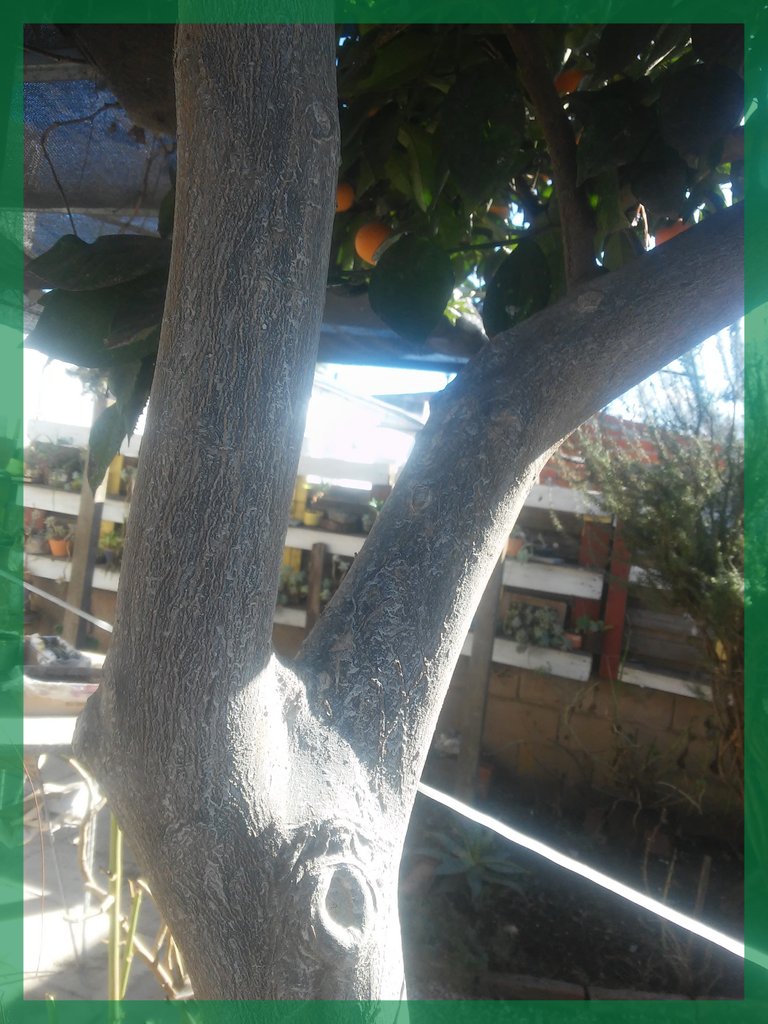
No pulverizar nunca sobre la flor porque eliminaremos la posibilidad de que nazca el fruto.
Apenas comiencen a salir las primeras hojas y las primeras flores haré otro post para mostrarles como va evolucionando la planta en general y los efectos del trabajo realizado.
Si los troncos son gruesos uso una sierra eléctrica de uso familiar, de esas que se usan para cortar pequeñas maderas, en fin de uso familiar no profesional.
Caso contrario mis herrmientas preferidas son el serrucho de podar y la clásica tijera (la mía tiene muchísimos años, es un regalo de mi padre) De cualquier en el comercio ambos elmentos no cuestan demasiado.
El objetivo de emplear la sierra es que el corte de la rama sea siempre oblicuo y neto para impedir el alojamiento prolungado del agua y el ingreso de cualquier plaga.
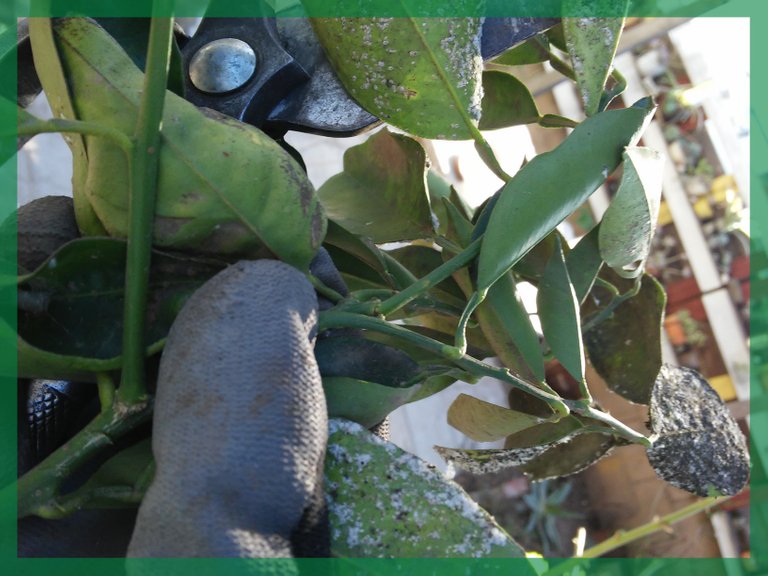
Una vez hecho el corte, con el pincel lo pintamos varias veces para que cicatrice rápidamente. En mi caso a la solución antes descripta la espeso bastante con una cucharada de cal viva de manera que quede dense y consistente, solo en este caso, para aplicar a los cortes efectuados.
También en este caso encuentran el el comercio productos en base a resina vegetal para favorecer la cicatrización de los cortes. Yo trato siempre de usar productos "domésticos", hechos en casa por mi mismo. Y dejo para comprar en el comercio aquello que verdaderamente no puedo obtener por mi mismo.
Otro aspecto muy importante es que las herramientas de corte (tijera y serrucho) estén bien afiladas para que las cortes sean netos.
Pulverizar tronco y ramas una vez efectuada la poda.
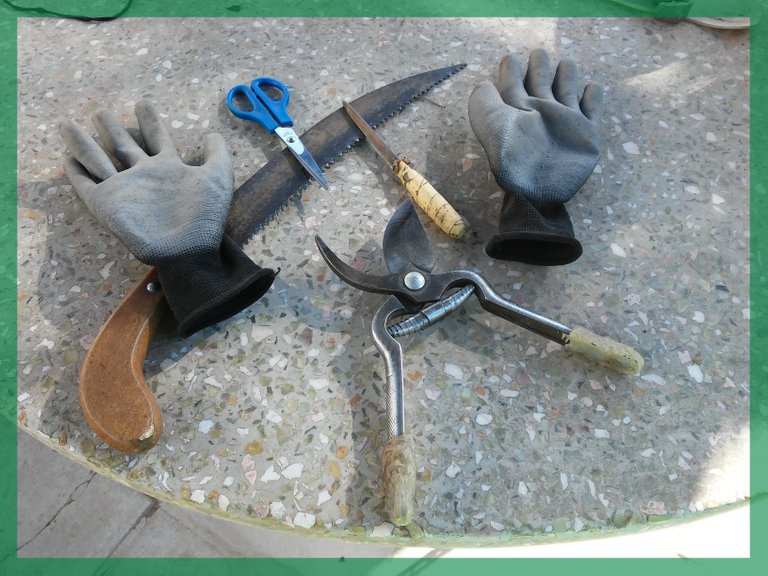 | 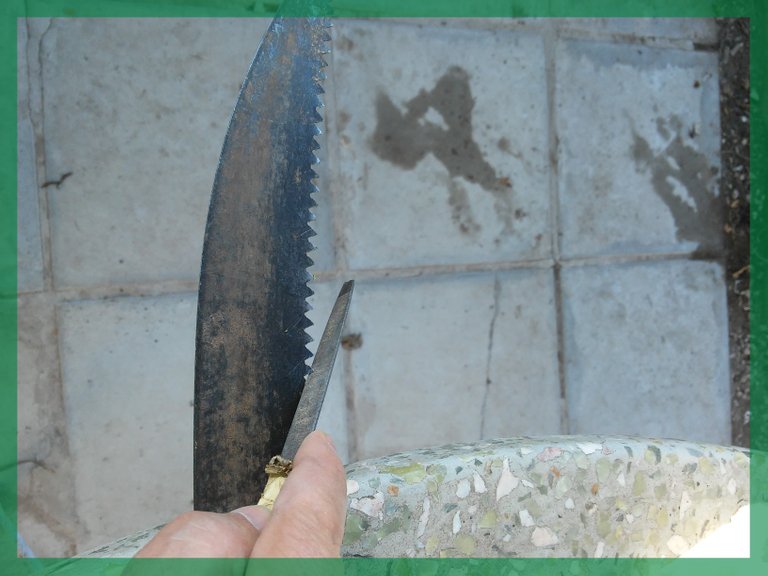 |
|---|
Probablemente nos de un poco de lástima ver a la planta totalmente despoblado de ramas y hojas, pero lo hemos hecho para su bien. Veremos que espléndida estará a mediados de primavera o inicios del verano.
Mientras tanto es hora de dedicarnos a la "pintura". Esta tarea la hacemos por única vez ya que después usaremos el pulverizar, mucho más rápida.
Pintamos con cuidado todo el tronco un par de veces para que la cal, el jabón potásico y el aceite de neem se abrsorban bien en el tronco.
Controlamos bien todas las hojas y con cuidado con un pincel eliminamos todos los residuos de la cochinilla blanca que veamos. El procedimiento es muy simple: giramos con delicadeza la hoja en el palmo de nuestra mano y la pintamos varias veces con el pincel con relativa energia hasta que hayamos eliminado la plaga.
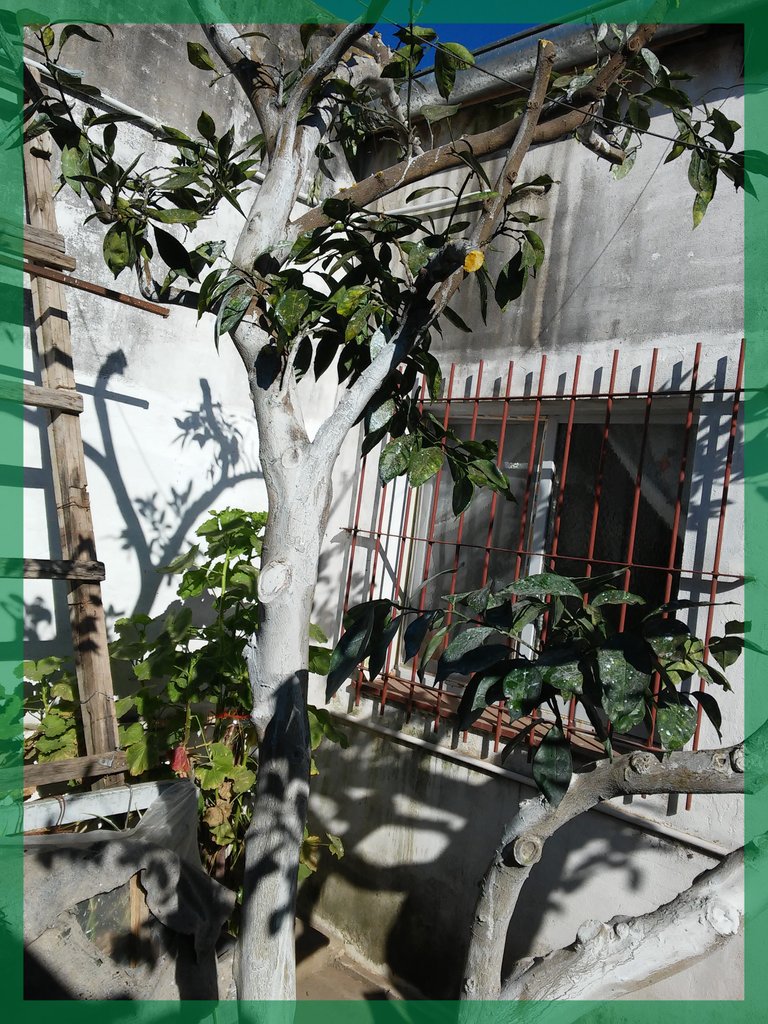
Luego pintamos que la rama y así sucesivamente hasta terminar toda la planta. Es necesario que le dejemos a la planta algunas hojas (un centenar o algo más está bien) ya que las necesita para respirar.
Caso contrario la planta se ahoga y comienza a fisurarse el tronco buscando oxigeno. Son las clasicas "llagas" que se ven en muchas plantas de frutales, en forma circular.
Una vez terminada la pintada esperamos una semana y ahora si, rociador en mano, le damos una buena pulverizada con la solución que hemos preparado en base a jabón potásico y aceite de neem diluídos en agua. La cal vida ya no es necesaria sino que además obstruiría el pulverizador.
En algunas fotos de este post ven el trabajo terminado en dos plantas de citricos (un mandarino y un naranjo) mientras en la restante planta (otro naranjo) está todo el trabajo para hacer. Es una variedad más lenta que florece y fructifica mas tarde. Y por lo tanto me da mas tiempo para la poda y la cura final.
Este post está escrito en el mes de agosto (primeros dias) a poco mas de un mes del inicio de la primavera.
Apenas el jardin haya sido invadido por las abejas, las nuevas yemas y las flores, prometo publicar el epilogo de esta historia.
Mientras tanto, nos seguimos leyendo!
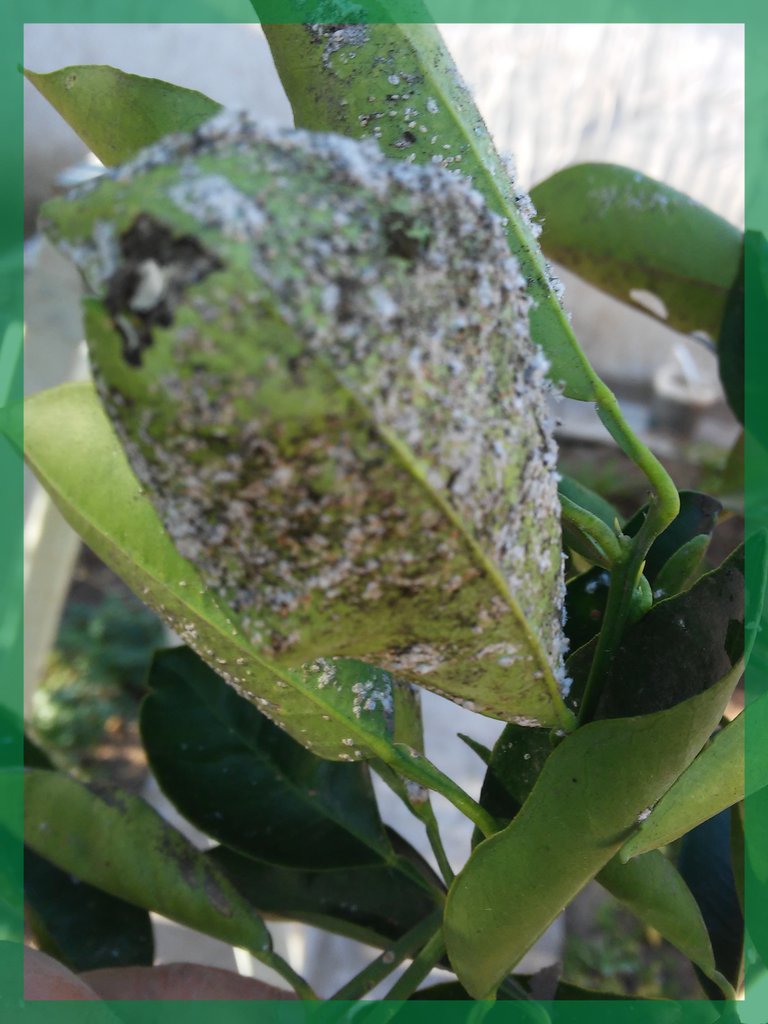
Translated with / Traducido con: www.DeepL.com/Translator (free version)
Own images. Text Separator / Imágenes propias. Separador de Textos : The Peak Studio



